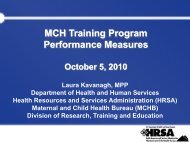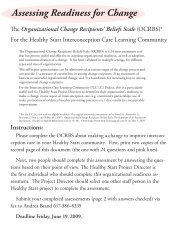The Future is Bright for Medical Home: Prevention and ... - HRSA
The Future is Bright for Medical Home: Prevention and ... - HRSA
The Future is Bright for Medical Home: Prevention and ... - HRSA
Create successful ePaper yourself
Turn your PDF publications into a flip-book with our unique Google optimized e-Paper software.
<strong>The</strong> <strong>Future</strong> <strong>is</strong> <strong>Bright</strong> <strong>for</strong> <strong>Medical</strong> <strong>Home</strong>:<br />
<strong>Prevention</strong> <strong>and</strong> Quality in the Context of <strong>Medical</strong><br />
<strong>Home</strong><br />
Jeanne McAll<strong>is</strong>ter, BSN, MS, MHA<br />
Paula Duncan, MD, FAAP<br />
Angela Tobin, AM, LSW<br />
Jane Bassewitz, MA
<strong>The</strong> <strong>Future</strong> <strong>is</strong> <strong>Bright</strong> <strong>for</strong> <strong>Medical</strong> <strong>Home</strong>:<br />
<strong>Prevention</strong> <strong>and</strong> Quality in the Context of<br />
<strong>Medical</strong> <strong>Home</strong><br />
Jeanne W. McAll<strong>is</strong>ter, BSN, MS, MHA<br />
www.medicalhomeimprovement.org<br />
di lh i t
<strong>Medical</strong> <strong>Home</strong>s: Living, Breathing, Complex Organizations
<strong>Medical</strong> home trans<strong>for</strong>mation <strong>for</strong> high quality<br />
care across the lifespan since 1993<br />
As a result of our session today learners learners will:<br />
• Explain the primary care medical home, its relationship to<br />
<strong>Bright</strong> <strong>Future</strong>s as a key preventive component, <strong>and</strong> d<strong>is</strong>cuss<br />
national, state <strong>and</strong> practice level activities of interest to all<br />
MCH partners.<br />
• Link quality q yimprovement p methodologies g to the achievement<br />
of improved/trans<strong>for</strong>med primary care<br />
• Explore key actions/roles around partnerships with health<br />
care teams teams, engagement of families <strong>and</strong> care coordination<br />
• D<strong>is</strong>cuss specific personal/professional strategies <strong>for</strong><br />
implementation that could be tried by learners "next week".
Agenda<br />
Welcome<br />
<strong>Medical</strong> <strong>Home</strong> <strong>and</strong> <strong>Bright</strong> <strong>Future</strong>s Overview<br />
• What <strong>is</strong> it?<br />
• How do they relate?<br />
• Quality Improvement strategies<br />
Buzz Group: Outreach to Primary Care<br />
Break<br />
Breakout Groups:<br />
• FFamily il EEngagement t<br />
• Care Coordination<br />
Next Steps: What can/will you do?
<strong>The</strong> Primary Care <strong>Medical</strong> <strong>Home</strong><br />
At the Crossroads Integrating:<br />
Vertically –among health care systems/special<strong>is</strong>ts/PCPs/patients & families<br />
HHorizontally i ll – among patients i & families/community f ili / i agencies/schools, i / h l etc …<br />
Continuously –with continuity of clinicians <strong>and</strong> medical home team members<br />
Longitudinally –over time with anticipatory guidance<br />
Health<br />
System<br />
Community<br />
Resources/Policies<br />
<strong>Medical</strong><br />
<strong>Home</strong><br />
Continuously<br />
Continuously…<br />
Longitudinally….
<strong>The</strong> Feeding <strong>and</strong> Nour<strong>is</strong>hing of a <strong>Medical</strong> <strong>Home</strong><br />
A Few Good Food Analogies<br />
Pollan & Graumbach<br />
NYTimes Dr. Graumbach<br />
Eat food Get health care<br />
Not too much Not too much<br />
Mostly plants Mostly primary care<br />
Nutting et al – (Lessons from first Trans<strong>for</strong>MED demonstration)<br />
Primary care ‐ like healthy food food, works best at a local <strong>and</strong> personal level<br />
Kingsolver & McAll<strong>is</strong>ter Tomatoes …<br />
Animal, , Vegetable, g , Miracle, , by y Barbara Kingsolver g
Part of the local community<br />
“Barter” or exchange assets<br />
Local Tomato Grower <strong>Medical</strong> <strong>Home</strong>?<br />
Value health, quality products, <strong>and</strong> safety<br />
Sell “product” directly to customers<br />
Livelihood <strong>is</strong> m<strong>is</strong>sion as well as business<br />
Customers show up week after week, at a community<br />
gathering place<br />
First names common; open door/welcoming policy<br />
Name of the heirloom tomato she <strong>is</strong> growing? { ? }
Local Tomato Grower <strong>Medical</strong> <strong>Home</strong>?<br />
Part of the local community ✔<br />
“Barter” or exchange assets ✔<br />
Value health, quality products, <strong>and</strong> safety ✔<br />
Sell “product” directly to customers ✔<br />
Livelihood <strong>is</strong> m<strong>is</strong>sion as well as business ✔<br />
Customers show up week after week, at a community<br />
gathering place<br />
First names common; open door/welcoming policy ✔<br />
Name of the heirloom tomato she <strong>is</strong> growing? { “TRUST” }<br />
✔
<strong>Medical</strong> <strong>Home</strong> – Timeline – <strong>The</strong> Pediatric Era<br />
1967 AAP centralized medical record = medical home<br />
1992 AAP Cal Sia –Hawaii<br />
• Pediatric <strong>Medical</strong> <strong>Home</strong>; coordinates care with early intervention<br />
1994 <strong>Bright</strong> <strong>Future</strong>s Guideines First publ<strong>is</strong>hed<br />
1996 AAP & MCHB<br />
• <strong>Medical</strong> <strong>Home</strong> initiatives ‐ children with special health care needs<br />
• CMHI applies li CQI methods th d to t office ffi practice ti change h methodology th d l<br />
2000 <strong>Bright</strong> <strong>Future</strong>s Guidelines –2nd Edition<br />
2002 AAP selected by MCHB to implemt the next phase of <strong>Bright</strong><br />
<strong>Future</strong>s Initiative<br />
2003 <strong>Medical</strong> <strong>Home</strong> Index –first quantitative measure of “medical<br />
homeness” homeness ‐ developed, validated, publ<strong>is</strong>hed‐CMHI<br />
publ<strong>is</strong>hed CMHI
<strong>Medical</strong> <strong>Home</strong> – Timeline – <strong>The</strong> Pediatric Era<br />
2003 2006 –1 st , 2 nd National <strong>Medical</strong> <strong>Home</strong> Learning Collaborative<br />
• MCHB funded partnership between CMHI <strong>and</strong> NICHQ<br />
AAP/MCHB National Center <strong>for</strong> <strong>Medical</strong> <strong>Home</strong><br />
Implementation /<strong>Medical</strong> <strong>Home</strong> Toolkit –uptakes CMHI/other<br />
tools l<br />
2007 <strong>Bright</strong> <strong>Future</strong>s, 3rd Edition Released<br />
2007 AAP was awarded a second cooperative agreement to address<br />
implementation<br />
2008 <strong>Bright</strong> <strong>Future</strong>s Tool <strong>and</strong> Resource Kit Released<br />
2010 CMHI awarded ddAHRQ AHRQ grant to study d medical di l hhome<br />
trans<strong>for</strong>mation<br />
CMHI awarded National Health Care Transition Center
A <strong>Medical</strong> <strong>Home</strong><br />
• Is a community‐based community based primary care setting which<br />
provides <strong>and</strong> coordinates high quality, planned,<br />
family‐centered health promotion <strong>and</strong> prevention,<br />
acute illness care, <strong>and</strong> chronic condition<br />
management —across the lifespan.<br />
– Care in a medical home <strong>is</strong> rewarding <strong>for</strong> clinical teams to provide<br />
<strong>and</strong> sat<strong>is</strong>fying <strong>for</strong> patients <strong>and</strong> families to receive
<strong>Medical</strong> <strong>Home</strong> – Timeline –Primary Care<br />
Trans<strong>for</strong>mation<br />
1970’s First mention in pediatric literature<br />
2004 AAFP publ<strong>is</strong>hes <strong>The</strong> <strong>Future</strong> of Family Medicine<br />
• <strong>Medical</strong> home model <strong>is</strong> the foundation<br />
2006 ACP promotes Advanced Primary Care<br />
• Uses medical home language <strong>and</strong> model<br />
2007 Joint Statement on the Primary Care <strong>Medical</strong> <strong>Home</strong><br />
• AAP, AAFP, ACP, <strong>and</strong> AOA; <strong>Medical</strong> home model as the st<strong>and</strong>ard of primary<br />
care<br />
2007 Er<strong>is</strong>a‐related Industries Committee launches the Patient‐Centered<br />
Primary Care Collaborative (PCPCC)<br />
• Pcpcc.net, (Waiting <strong>for</strong> pediatric incentives)<br />
New—Current New Current (January 2010 2010‐2011) 2011)<br />
• Medicare Advanced Primary Care Pilot Demonstrations…<br />
• Af<strong>for</strong>dable Care Act<br />
• AHRQ Trans<strong>for</strong>mation Studies (1 of 14 a pediatric study!)
Accountable Care Organizations<br />
Key Elements<br />
• Pi Primary CCare i<strong>is</strong> ffoundational d i l<br />
• Define Roles of Subspecial<strong>is</strong>ts<br />
• Dfi Define Role R l of f HHospitals it l<br />
• Governance<br />
• Define Population<br />
Challenges<br />
• R<strong>is</strong>k Adjustment<br />
• Time Horizon <strong>for</strong> Outcomes
Leveraging Opportunities<br />
Af<strong>for</strong>dable Care Act<br />
• Quality primary care, extended age to remain on family plan, no charge<br />
preventative care<br />
<strong>Medical</strong> <strong>Home</strong> – st<strong>and</strong>ards <strong>for</strong> recognition<br />
• Reimbursement potential <strong>for</strong> population care/reg<strong>is</strong>tries, care plans,<br />
coordination coordination, population population, reg<strong>is</strong>tries reg<strong>is</strong>tries, care plans, plans etc. etc<br />
• Youth/family involvement, partnership <strong>and</strong> leadership<br />
• Professional Organizations (AAP, AAFP, ACP, AANP etc.)<br />
– Resources/toolkits / lk<br />
– Education, skills, proficiencies<br />
– Clinical training/residencies<br />
– MOC<br />
Accountable Care Organizations<br />
– Primary y<br />
Care <strong>is</strong> foundational
Families Want <strong>and</strong> Need<br />
• Offers a collaborative family family‐<br />
centered, team approach<br />
• Develops p a written summary y<br />
of critical care in<strong>for</strong>mation<br />
• Has a developed p pprocess<br />
to<br />
integrate <strong>and</strong> coordinate care<br />
across multiple services
Emphas<strong>is</strong> on partnerships with families<br />
Continuum of ways y to engage gg p patients & families, ,<br />
as:
Every Child, Youth, & Adult<br />
Benefits from a Proactive, Planned, <strong>and</strong> Coordinated <strong>Medical</strong> <strong>Home</strong><br />
• Jamie, an 11‐yo female, affected by Spina Bifida, arrives at<br />
pediatricians <strong>for</strong> a well child examination.<br />
examination<br />
• Special<strong>is</strong>ts—orthoped<strong>is</strong>t, urolog<strong>is</strong>t, <strong>and</strong> neurosurgeon<br />
• Jamie’s mother has two pressing concerns:<br />
1) JJamie i <strong>is</strong> i pubescent; b t will ill likely lik l begin b i menstruating t ti soon<br />
oHow to h<strong>and</strong>le th<strong>is</strong> event given Jamie’s catheterization program, (both<br />
at school <strong>and</strong> home).<br />
o Jamie’s Jamie s father has declared he does not want to be a part of Jamie Jamie’ss<br />
“home team” once menarche has occurred.<br />
2) Jamie endures teasing at school because her periodic urine leakage<br />
leaves an odor.<br />
o<strong>The</strong> office nurse finds that none of the recent special<strong>is</strong>t’s notes have<br />
arrived &<br />
o<strong>The</strong> PCP did not plan time to address these concerns today…
Jamie in a <strong>Medical</strong> <strong>Home</strong><br />
Proactive, Planned, Coordinated Care<br />
Time Form trusting partnership with care team.<br />
Teamwork <strong>for</strong><br />
Team <strong>is</strong> getting stronger; partner in helping<br />
Jamie to take a more active role/ progressively plan<br />
increased independence<br />
Care Plan Team & family develop, use, <strong>and</strong> share a<br />
plan of care<br />
Learning to partner<br />
in care <br />
Jamie, encouraged, begins to ask questions; she<br />
contacts her coordinator <strong>for</strong> ass<strong>is</strong>tance or questions<br />
Explicit p roles Family y underst<strong>and</strong>s their role<br />
‐ Prepare questions, maintain records, <strong>and</strong> ensure<br />
evaluations or tests are sent regularly<br />
Events Coordination & community outreach;<br />
‐ Gather in<strong>for</strong>mation about events: school/urgent care/ER/<br />
hospitalizations—family underst<strong>and</strong>s staff want <strong>and</strong> need to<br />
be in<strong>for</strong>med<br />
Leadership Family’s ability to lead <strong>is</strong> variable/may at times need<br />
more active ti engagement t of f coordinator di t & team.<br />
t
Measuring the <strong>Medical</strong> <strong>Home</strong><br />
• Quality Assurance Assurance—Do Do you meet st<strong>and</strong>ards?<br />
– National Committee <strong>for</strong> Quality Assurance (NCQA)<br />
• 10 St<strong>and</strong>ards; Levels 1, 2, <strong>and</strong> 3<br />
• Basic requirement <strong>for</strong> many pilots<br />
• Quality Improvement—Where you are on the<br />
medical home continuum?<br />
– CMHI <strong>Medical</strong> <strong>Home</strong> Index (Validation Study 2003)<br />
– <strong>Medical</strong> <strong>Home</strong> Family Index & Survey<br />
• Pediatric & adult versions: long & short <strong>for</strong>ms
<strong>The</strong> CMHI <strong>Medical</strong> <strong>Home</strong> Index<br />
6 Domains (25 <strong>The</strong>mes)<br />
• Organizational Capacity (7)<br />
• Chronic Condition Management (6)<br />
• Care Coordination (6)<br />
• Community Outreach (2)<br />
• Data Management (2)<br />
• Quality Improvement/Change (2)<br />
Cooley Cooley, McAll<strong>is</strong>ter McAll<strong>is</strong>ter, Sherrieb, Sherrieb & Clark; Ambulatory Pediatrics, Pediatrics July 2003
Support pp <strong>for</strong> ppediatric trans<strong>for</strong>mation leads to 30% improvement p overall in 3 years, y<br />
n=10.
Pediatric <strong>Medical</strong> <strong>Home</strong><br />
Family Outcome Data of Significance<br />
• ↑ Family y feedback<br />
• ↑ Care plans/summary<br />
• ↑ Health status<br />
• ↓ Parental Worry<br />
• ↓ School absences<br />
• ↓ ER, hospitalizations, & specialty v<strong>is</strong>its<br />
Pre & Post n=83 data sets, (p‐value of
CMHI National Outcomes Study<br />
Cost/Utilization<br />
<strong>Medical</strong> <strong>Home</strong> Index; 43 Practices, 7 Plans/5 States<br />
– Higher overall MHI scores or higher domain scores<br />
<strong>for</strong> care coordination coordination, chronic condition<br />
management, office organizational capacity<br />
• Lower hospitalization rates<br />
– Higher Chronic Condition Management domain<br />
scores<br />
• Fewer ER v<strong>is</strong>its<br />
Cooley, McAll<strong>is</strong>ter, Sherrieb, Kuhlthau, Pediatrics, July 2009
Where does practice<br />
support come from<br />
now?<br />
What does it take?
CMHI Lessons Learned<br />
• Patient/family engagement<br />
– GGuidance id & vitality it lit ( (see continuum ti of f strategies t t i slide) lid )<br />
• Trans<strong>for</strong>mation help<br />
Support pp redesign g <strong>and</strong> improvement p processes p<br />
– Guide with their personal mastery<br />
• Teamwork, access, population approaches, coordinated planned care,<br />
technology skills, etc.<br />
• Leadership<br />
Alignment of messages from all interested/investing in<br />
primary care<br />
• Payment re<strong>for</strong>m<br />
& reinvest payment into primary care infrastructure/<br />
coordination of care
CMHI’s CMHI s TAPPP (Gap) Analys<strong>is</strong>:<br />
A <strong>Medical</strong> <strong>Home</strong> Assessment with Trans<strong>for</strong>mation &<br />
Measurement Methods<br />
• Teamwork<br />
• Access & Communication<br />
• Population Approach<br />
• Planned, Coordinated Care<br />
• Patient & Family‐Centered Care
TAPPP TAPPP (Pediatric & Adult Adult Versions)<br />
Incorporates:<br />
• <strong>Medical</strong> <strong>Home</strong> Definition<br />
• <strong>Medical</strong> <strong>Home</strong> Index<br />
• Elements from:<br />
– Care Model <strong>for</strong> Child Health in the <strong>Medical</strong> <strong>Home</strong><br />
– PCMH St<strong>and</strong>ards<br />
– Other criteria<br />
• CMHI lessons learned –what it takes
CMHI ‐ TAPPP Process
Patient & Family‐Centered <strong>Medical</strong> <strong>Home</strong><br />
Across the lifespan <strong>for</strong> children, youth <strong>and</strong> adults<br />
Re<strong>for</strong>med Coverage & Continuous Trans<strong>for</strong>mation<br />
Re<strong>for</strong>med Coverage & Continuous Trans<strong>for</strong>mation<br />
Supports
References/Resources<br />
• McAll<strong>is</strong>ter JW, Presler E, Turchi R, Antonelli RC. Achieving Effective Care Coordination in the<br />
<strong>Medical</strong> <strong>Home</strong>. Pediatric Annals. 2009:38(10)<br />
• McAll<strong>is</strong>ter JW, Sherrieb K, Cooley WC. Improvement in the Family‐Centered Family Centered <strong>Medical</strong> <strong>Home</strong><br />
Enhances Outcomes <strong>for</strong> Children & Youth with Special Health Care Needs. Journal of<br />
Ambulatory Care Management. 2009:32(3);188‐196<br />
• Cooley WC, McAll<strong>is</strong>ter JW, Sherrieb K, Kulthau K. Improved Chronic Condition Outcomes<br />
Associated with <strong>Medical</strong> <strong>Home</strong> Implementation in Pediatric Primary Care. Pediatrics.<br />
2009:358‐364<br />
• Antonelli RW, McAll<strong>is</strong>ter JW, Popp J. Developing Care Coordination as a Critical Component<br />
of a High Per<strong>for</strong>mance Pediatric Health Care System. A Commonwealth Fund Report. 2009<br />
(www.commonwealthfund.org)<br />
• McAll<strong>is</strong>ter JW, Presler E, Cooley WC. Practice‐Based Care Coordination: A <strong>Medical</strong> <strong>Home</strong><br />
Essential. Pediatrics. 2007;120;e723‐e733.<br />
• Cooley WC, McAll<strong>is</strong>ter JW. Building <strong>Medical</strong> <strong>Home</strong>s: Improvement Strategies in Primary<br />
Care <strong>for</strong> Children with Special Health Care Needs Needs. Pediatrics Pediatrics. 2004;113:1499 2004;113:1499‐1506 1506<br />
• Cooley WC, McAll<strong>is</strong>ter JW, Sherrieb K, Clark RE. <strong>The</strong> <strong>Medical</strong> <strong>Home</strong> Index: Development<br />
<strong>and</strong> Validation of a New Practice‐level Measure of Implementation of the <strong>Medical</strong> <strong>Home</strong><br />
Model. Ambulatory Pediatrics. 2003:3(4);173‐180<br />
• AAP/MCHB BBuilding ildi YYour Mdi <strong>Medical</strong> lH<strong>Home</strong> TToolkit. lkit www.pediatricsmedhome.org<br />
di t i dh
<strong>Bright</strong> <strong>Future</strong>s: Health<br />
Promotion/D<strong>is</strong>ease<br />
<strong>Prevention</strong> in the <strong>Medical</strong><br />
<strong>Home</strong><br />
At the heart of the medical home <strong>is</strong> the<br />
relationship between the clinician <strong>and</strong> the<br />
ffamily l or youthh
<strong>Bright</strong> <strong>Future</strong>s: Guidelines <strong>for</strong> Health<br />
Superv<strong>is</strong>ion of Infants, Children, <strong>and</strong><br />
Adolescents, 3rd Edition<br />
Paula Duncan, MD, FAAP<br />
AMCHP Annual Meeting<br />
February 2011
H<strong>is</strong>tory of the <strong>Bright</strong> <strong>Future</strong>s Guidelines<br />
Supported <strong>and</strong> funded by the Maternal <strong>and</strong> Child Health<br />
Bureau (MCHB) of the Health Resources <strong>and</strong> Services<br />
Admin<strong>is</strong>tration (<strong>HRSA</strong>), Department of Health <strong>and</strong> Human<br />
Services<br />
• First publ<strong>is</strong>hed in 1994<br />
• Updated in 2000—2nd edition<br />
• In 2002, AAP selected by MCHB to implement the next<br />
phase of the initiative<br />
• 3rd edition released in October 2007<br />
• In 2007, the AAP was awarded a second cooperative<br />
agreement to address implementation.
Development p of<br />
<strong>The</strong> <strong>Bright</strong> <strong>Future</strong>s Guidelines, 3 rd Ed.<br />
<strong>The</strong> M<strong>is</strong>sion<br />
– Develop one set of uni<strong>for</strong>m guidelines <strong>for</strong> the health<br />
superv<strong>is</strong>ion/well care of infants infants, children children, adolescents<br />
<strong>and</strong> young adults<br />
– Address biopsychosocial <strong>is</strong>sues impacting on child<br />
health<br />
– Strengthen medical homes<br />
– Use interventions which are evidence driven<br />
– Include recommendations on immunizations, routine<br />
health screening, <strong>and</strong> anticipatory guidance
Development p of<br />
<strong>The</strong> <strong>Bright</strong> <strong>Future</strong>s Guidelines, 3 rd Ed.<br />
• Our process<br />
– 4 Multid<strong>is</strong>ciplinary Age‐Stage Expert Panels<br />
• IInfancy f<br />
• Early Childhood<br />
• Middl Middle Childh Childhoodd<br />
• Adolescence<br />
– Numerous AAP Leadership Groups Groups, including the AAP<br />
Committee on Practice <strong>and</strong> Ambulatory Medicine<br />
(co‐authors (co authors of the AAP Periodicity Schedule)
Development p of<br />
<strong>The</strong> <strong>Bright</strong> <strong>Future</strong>s Guidelines, 3 rd Ed.<br />
• Our process<br />
– Evidence Panel<br />
• NNominated i d<strong>and</strong> d SSelected l d<br />
• Worked with each age/stage panel<br />
– Child Children <strong>and</strong> d Youth Y thWith With Special S i lH Health lthCCare NNeeds d<br />
Panel<br />
• Nominated <strong>and</strong> Selected<br />
• Worked with each age/stage panel
2000 & 2002<br />
…<strong>is</strong> a set of principles,<br />
strategies <strong>and</strong> tools that<br />
are th theory ‐ bbased, d<br />
evidence ‐ driven, <strong>and</strong><br />
systems y ‐ oriented, , that<br />
can be used to improve<br />
the health <strong>and</strong> well‐<br />
being of all children<br />
through culturally<br />
appropriate pp p<br />
interventions that<br />
address the current <strong>and</strong><br />
emerging health<br />
promotion needs at the<br />
family, clinical practice,<br />
community, health<br />
system <strong>and</strong> policy levels.
HHealth lthCCare Re<strong>for</strong>m Rf<br />
•“With “ respect to infants, children, <strong>and</strong> adolescents,<br />
evidence‐in<strong>for</strong>med preventive care <strong>and</strong> screenings<br />
provided <strong>for</strong> in the comprehensive guidelines supported<br />
by the Health Resources <strong>and</strong> Services Admin<strong>is</strong>tration<br />
(<strong>HRSA</strong>).” (<strong>HRSA</strong>).<br />
•Recognizes that <strong>Bright</strong> <strong>Future</strong> Health Superv<strong>is</strong>ion V<strong>is</strong>its<br />
are the guidelines g referred to as “Recommended<br />
Guidelines”
Developing the Guidelines<br />
• Structure<br />
– Part I—<strong>The</strong>mes<br />
– Includes 10 chapters highlighting key health promotion<br />
themes<br />
– Emphasizes “significant challenges”—mental health<br />
<strong>and</strong> healthy weight<br />
– Part II—V<strong>is</strong>its<br />
– Provides detailed health superv<strong>is</strong>ion guidance <strong>and</strong><br />
anticipatory guidance <strong>for</strong> 31 age‐specific v<strong>is</strong>its<br />
– L<strong>is</strong>ts 5 priorities <strong>for</strong> each v<strong>is</strong>it<br />
– Includes sample questions <strong>and</strong> d<strong>is</strong>cussion topics <strong>for</strong><br />
parent <strong>and</strong> child
Developing the Guidelines<br />
• Health ea t Superv<strong>is</strong>ion Supe s o Priorities o tes<br />
– Designed to focus v<strong>is</strong>it on most important <strong>is</strong>sues <strong>for</strong><br />
age of child<br />
– AAnticipatory i i guidance id presented d in i several l ways<br />
– Include health r<strong>is</strong>ks, developmental <strong>is</strong>sues, positive<br />
rein<strong>for</strong>cement
PPeriodicity i di it Schedule<br />
Shdl
Setting the<br />
agenda<br />
M<strong>Medical</strong> di l<br />
Screening<br />
Developmental<br />
p<br />
Surveillance
Vermont Child Health Improvement Project<br />
Let’s ’ think about Samantha <strong>and</strong> Tiffany<br />
• Samantha age 22 <strong>and</strong> Tiffany age 18 months have been<br />
living in the shelter <strong>for</strong> about four months<br />
• Lived with mom but left abruptly<br />
• Doesn’t Doesn t follow through with finding childcare <strong>for</strong> Tiffany<br />
•Has a boyfriend who lives with h<strong>is</strong> mom
Vermont Child Health Improvement Project<br />
Worried about<br />
additional shots<br />
shots<br />
because<br />
boyfriend boyfriend’s s<br />
mother had a<br />
child with aut<strong>is</strong>m<br />
<strong>The</strong>re <strong>is</strong> a family from<br />
Laos at the homeless<br />
shelter; h lt child hild had hdb been<br />
playing with their<br />
children
Vermont Child Health Improvement Project<br />
• Helps out at the shelter with reading‐<br />
went to the h lib library to get the h bbooks k<br />
(Helps out)<br />
• WWants t to t hhave hher ddaughter ht grow up always l ffeeling li<br />
safe <strong>and</strong> smoke‐ free ( independent dec<strong>is</strong>ion‐making<br />
• Fin<strong>is</strong>hed her GED GED, works as a waitress waitress, never<br />
interacted with an agency be<strong>for</strong>e (Mastery)<br />
• Has a partner who has been with her <strong>and</strong> Samantha<br />
<strong>for</strong> 6 months – lives with h<strong>is</strong> parents (Belonging)
<strong>Bright</strong> <strong>Future</strong>s Implementation<br />
• <strong>Bright</strong> <strong>Future</strong>s Guidelines, 3 d rd Edition<br />
– Implementation<br />
– MMeasurement of f Bih <strong>Bright</strong> F<strong>Future</strong>s.<br />
• BihtF <strong>Bright</strong> <strong>Future</strong>s t measures encompass rigorous i national ti l<br />
measures but also integrate the comprehensive<br />
recommendations necessary y to pprovide quality q yp preventive<br />
care.
CDC Domestic D ti Winnable Wi bl Battles Bttl<br />
• Obesity, Nutrition, Physical Activity, <strong>and</strong> Food Safety<br />
• Teen Pregnancy<br />
• Motor Vehicle Injuries<br />
• Tobacco<br />
• HIV<br />
• Healthcare Associated Infections
<strong>Bright</strong> <strong>Future</strong>s Quality Measures Crosswalk
Compar<strong>is</strong>on p of Components p at Baseline<br />
<strong>and</strong> Follow‐up<br />
Perceent<br />
of Childrenn<br />
With Positivve<br />
Result Docuumented<br />
Percent of Children Age 0-5 Years In 15 <strong>Bright</strong> <strong>Future</strong>s Training<br />
Intervention Practices With 4 <strong>Bright</strong> <strong>Future</strong>s Outcomes Documented<br />
by Chart Review At Baseline <strong>and</strong> Follow-Up<br />
100<br />
80<br />
60<br />
40<br />
20<br />
0<br />
Preventive<br />
Services<br />
Prompting<br />
System<br />
<strong>Bright</strong> <strong>Future</strong>s Training Intervention Project<br />
Structured<br />
Developmental<br />
Assessment<br />
Special<br />
Healthcare Needs<br />
Identified<br />
Structured<br />
Assessment of<br />
Parent Strengths<br />
<strong>and</strong> Needs<br />
Baseline* Baseline<br />
Follow-Up**
Results from 2009 office intervention( (<br />
VCHIP 2011)<br />
YHII Pre vs. Post Office Based Education Changes<br />
by Training Topic<br />
Percent Change in Rates of Composite<br />
Measures of R<strong>is</strong>ks <strong>and</strong> Strengths
Quality Q yImprovement p in Practice Preventive<br />
Services to Improve Patient Outcomes<br />
Use ex<strong>is</strong>ting mechan<strong>is</strong>ms:<br />
– Maintenance of certification<br />
• AAP chapter p activities<br />
• AAP Education in Quality Improvement in Pediatric<br />
Practice (EQIPP)<br />
• Improvement Partnerships<br />
– Link with National Committee <strong>for</strong> Quality Assurance (NCQA)<br />
medical home scoring <strong>and</strong> reimbursement<br />
– Accreditation Council <strong>for</strong> Graduate <strong>Medical</strong> Education<br />
(ACGME) requirements <strong>for</strong> residency program<br />
– Presentations at partner national meetings
NNew AApproaches h<br />
• National AAP Preventive Services Implementation<br />
Project (Jan –Oct 2011)<br />
– Pediatricians, , family y pphysicians, y , nurse practitioners p ,<br />
physician ass<strong>is</strong>tants,<br />
in<br />
– Rural, urban <strong>and</strong> suburban practices <strong>and</strong> clinics as<br />
well as community health centers <strong>and</strong> the Indian<br />
Health service<br />
• Partner with Health Plan <strong>and</strong> Medicaid QI activities (e.g.<br />
CHIPRA)
RRev<strong>is</strong>ion i i PProcess<br />
• <strong>Bright</strong> <strong>Future</strong> Guidelines, 3 d rd Edition, Rev<strong>is</strong>ion<br />
– Evidence in USPSTF, CDC Community Guide <strong>and</strong><br />
CCochrane h<br />
– Expert Opinion/Clinical Guidelines that change<br />
Uni Universal ersal or Selective Selecti e Screening<br />
– Implementation Projects Lessons Learned<br />
– RReview i bby EExpert PPanel lCh Chairs i <strong>and</strong> d AAP Eid Evidence<br />
Experts
Rf References<br />
Hagan JF, Shaw JS, Duncan PM, eds. 2008. 2008. <strong>Bright</strong> <strong>Future</strong>s:<br />
Guidelines <strong>for</strong> Health Superv<strong>is</strong>ion of Infants, Children <strong>and</strong><br />
Adolescents, Third Edition. Elk Grove Village, IL: American<br />
Academy of Pediatrics<br />
Lannon CM, Flower K, Duncan P, Moore KS, Stuart J, Bassewitz J.<br />
Th <strong>The</strong> BihtF <strong>Bright</strong> <strong>Future</strong>s t TTraining i i IIntervention t ti PProject: j t iimplementing l ti<br />
systems to support preventive <strong>and</strong> developmental services in<br />
practice. Pediatrics. 2008;122 e163‐e171<br />
http://www.cdc.gov/about/winnablebattles.htm
Buzz Activity<br />
• What <strong>is</strong> your charge as you underst<strong>and</strong> it in linking<br />
public health <strong>and</strong> primary care?<br />
• What prepares p p yyou<br />
to do th<strong>is</strong>?<br />
• What has been working well in achieving th<strong>is</strong><br />
linkage? g<br />
• How do we replicate these successful strategies?
OOutreach t htto Pi Primary CCare – Si Simple l St Steps<br />
• PPartnerships t hi<br />
• Lunches<br />
• Joint offerings<br />
• Scholarships<br />
• Collaboratives<br />
• Share data<br />
• Share family feedback<br />
• Link coordinators
Outreach to Primary Care<br />
• Various Levels of Quality Improvement, based on<br />
experience i<br />
• Level 1<br />
• Level 2<br />
• Level 3<br />
• Use Quality Improvement Strategies<br />
• Build on the public health model (data‐action–data)<br />
• Adopt or establ<strong>is</strong>h guidelines, (eg <strong>Bright</strong> <strong>Future</strong>s <strong>for</strong><br />
EPSDT )<br />
• Consider partnership with AAP or AAFP chapters <strong>and</strong><br />
medical schools
Outreach to Primary Care<br />
• Use <strong>Medical</strong> <strong>Home</strong> Payment Re<strong>for</strong>m Incentives<br />
– In some states payment re<strong>for</strong>m has been linked to<br />
recognition under the NCQA PCMH st<strong>and</strong>ards.<br />
– Other states are using unique scoring systems.<br />
– Some are not pursuing payment re<strong>for</strong>m at th<strong>is</strong> time.
Outreach to Primary Care<br />
• For Pediatricians, the use of new 2010 Maintenance<br />
of Certification (MOC) requirements <strong>is</strong> an incentive<br />
– Consider partnership with AAP chapter <strong>and</strong> medical school<br />
to develop <strong>and</strong> submit an MOC application to the<br />
American Board of Pediatrics<br />
– Topics: medical home home, preventive services services, obesity obesity,<br />
developmental screening, asthma, etc.<br />
– Need 40 points
Outreach to Primary Care<br />
• Choice<br />
• True partnership with respect<br />
• Willingness to try something new (co‐location)<br />
• Easy as possible<br />
• Find a champion/partner<br />
p /p<br />
• Look <strong>for</strong> flexibility in practice/clinic structure<br />
• Celebrate small steps
Outreach to Primary Care<br />
• Accelerate the Process<br />
– Consider AAP <strong>and</strong> AAFP chapter grants on shared<br />
outcomes<br />
– Form an Improvement Partnership (Paula)
Improvement Partnership<br />
…a durable, regional collaboration of public <strong>and</strong> private<br />
…a durable, regional collaboration of public <strong>and</strong> private<br />
partners that uses measurement‐based ef<strong>for</strong>ts <strong>and</strong> a<br />
systems approach to improve the quality of children’s<br />
health care.
Why are States Developing Improvement<br />
Partnerships?<br />
• Investments in improving the health care of children<br />
• Recognition <strong>and</strong> embracing the local expert<strong>is</strong>e – “all<br />
improvement p <strong>is</strong> local”<br />
• Innovation <strong>and</strong> success in the State <strong>is</strong> often not<br />
connected nor broadly y d<strong>is</strong>seminated, limiting g the<br />
impact on child health outcomes
VERMONT CHILD HEALTH IMPROVEMENT PROGRAM<br />
.<br />
<strong>The</strong> OKlahoma Key<br />
to Improving<br />
Developmental-<br />
Behavioral Services
What Do Improvement Partnerships Do?<br />
• Develop p <strong>and</strong> test tools, , measures <strong>and</strong> strategies g<br />
• Serve as a resource <strong>for</strong> improvement ass<strong>is</strong>tance<br />
• Translate knowledge g through g engagement gg of<br />
national <strong>and</strong> local experts<br />
• D<strong>is</strong>seminate findings, spreading successful<br />
approaches h <strong>and</strong> d iin<strong>for</strong>ming f i policy li<br />
• Serve as convener, “honest broker”
AZ<br />
NM<br />
VT<br />
UT<br />
WV<br />
• Convener <strong>for</strong> the States<br />
• Sharing, problem solving <strong>and</strong><br />
connecting states/regions<br />
• Repository <strong>for</strong> tools, materials,<br />
speakers<br />
RI<br />
WA<br />
NY<br />
OR<br />
CT<br />
MI • Tech ass<strong>is</strong>tance/Mentor<br />
‐ developing an IP<br />
OK<br />
MN<br />
• Adv<strong>is</strong>ory to federal government<br />
<strong>and</strong> other national initiatives<br />
• Scholarship ‐ publ<strong>is</strong>hing results<br />
• Shaping funding opportunities<br />
DC<br />
OH
Six Core Outcomes (Charge to All of US)<br />
• Children will be screened early <strong>and</strong> continuously <strong>for</strong><br />
special health care need<br />
• Families of CSHCN will participate in dec<strong>is</strong>ion making at<br />
all levels <strong>and</strong> will be sat<strong>is</strong>fied with the services they<br />
receive<br />
• CSHCN will receive regular ongoing comprehensive care<br />
within a medical home.<br />
• Families of CSHCN will have adequate public <strong>and</strong>/or<br />
private insurance to pay <strong>for</strong> the services they need.<br />
• Community‐based service systems will be organized so<br />
families can use them easily<br />
• Youth with special health care needs (YSHCN) will receive<br />
the services necessary to make transitions to all aspects<br />
of adult life life.
Break 10"<br />
D<strong>is</strong>cussion Groups:<br />
Family Engagement<br />
Care Coordination
Family Engagement<br />
• Title V /state level<br />
– Support practice /clinic level data collection <strong>and</strong><br />
improvement activties<br />
– Provide tools. Analyze data<br />
– Materials <strong>and</strong> strategies <strong>for</strong> improvement<br />
– Parent adv<strong>is</strong>ory committee or members on all<br />
committees<br />
– Employ parents as team professionals<br />
– Support parent to parent groups
Family Engagement<br />
• At the medical home level<br />
– Share materials that involve parents in the v<strong>is</strong>it<br />
• prev<strong>is</strong>it questionnaires<br />
• Prev<strong>is</strong>it developmental screening tools<br />
• H<strong>and</strong>outs<br />
– Consider shared documentation <strong>for</strong>ms<br />
– Survey data from parents (PHDS)<br />
– Parents/youth practice adv<strong>is</strong>ory committee<br />
– Employ parents as navigators <strong>and</strong> parent adv<strong>is</strong>ors
<strong>Medical</strong> <strong>Home</strong> Index Family y<br />
Involvement –Care Coordination<br />
• Asked what care supports parents need <strong>and</strong> shared<br />
dec<strong>is</strong>ions<br />
• Given option of centralizing care coordination<br />
• Involved with care coordinator
Family Feedback Organizational Capacity<br />
• Elicited individually <strong>and</strong> shared with others<br />
• SSurveys, ffocus groups, iinterviews i<br />
• Tan ible s pports in pla e <strong>for</strong> parents to parti ipate<br />
• Tangible supports in place <strong>for</strong> parents to participate<br />
in practice needs assessment <strong>and</strong> solutions
Family Engagement – D<strong>is</strong>cussion<br />
• How do you involve families <strong>and</strong> MCH at the state<br />
<strong>and</strong> local level?<br />
• How do you encourage medical homes to involve<br />
families?
Care Coordination<br />
• Public health <strong>and</strong> the medical home<br />
– Care Coordination
<strong>The</strong> Primary Care <strong>Medical</strong> <strong>Home</strong><br />
At the Crossroads Integrating:<br />
• Vertically –among health care systems/special<strong>is</strong>ts/PCPs/families<br />
• HHorizontally i ll – among ffamilies/community ili / i agencies/schools i / h l etc …<br />
• Longitudinally –over time<br />
• Continuously – continuity of provider <strong>and</strong> team<br />
Community Co u ty<br />
Resources/Policies<br />
Health<br />
System<br />
<strong>Medical</strong><br />
<strong>Home</strong><br />
Continuously… i l<br />
Longitudinally….<br />
Opportunities <strong>and</strong> need <strong>for</strong> care coordination functions/care coordinators.
CMWF Framework Framework—AA Definition<br />
• Care coordination <strong>is</strong> a patient p <strong>and</strong><br />
family‐centered, assessment driven,<br />
team‐based activity …<br />
– …designed d i dto meet the h needs d of f children, hild youth h <strong>and</strong> d adults d l<br />
while enhancing the care giving capabilities of families.<br />
– …care coordination addresses interrelated medical, social,<br />
developmental, behavioral, educational <strong>and</strong> financial needs<br />
in order to achieve optimal health <strong>and</strong> wellness outcomes<br />
Antonelli, McAll<strong>is</strong>ter, Popp, 2009
Components of CC<br />
• Patient & Family‐centered y<br />
• Community‐based<br />
• Proactive, Providing Planned, Comprehensive Care<br />
• Promotes the Development of Self‐Management<br />
Skills (Care Partnership Support) with Children,<br />
Youth, Adults <strong>and</strong> Families<br />
• Facilitates cross‐organizational linkages <strong>and</strong><br />
relationships<br />
Antonelli Antonelli, McAll<strong>is</strong>ter, McAll<strong>is</strong>ter Popp, Popp 2009
Delivery of Patient & Family‐Centered Care Coordination Services
CC Functions<br />
• Provides separate CC v<strong>is</strong>its<br />
• CCompletes/analyzes l / l assessments<br />
• Manages continuous communications<br />
• Develops care plans with patients/families<br />
• Manages/tracks tests, referrals, <strong>and</strong> outcomes<br />
• Coaches patients/families<br />
p /<br />
• Integrates/consolidates critical care in<strong>for</strong>mation<br />
• Supports/facilitates care transitions (pedi, adult,<br />
nursing i hhome, hospital, h it l etc.) t )<br />
• Facilitates (participates in) team meetings<br />
• Uses health in<strong>for</strong>mation technology (IT)
Our <strong>Medical</strong> <strong>Home</strong> Until<br />
1:30 p.m. 2/15/01<br />
Support<br />
Family &<br />
Friends<br />
FAMILY<br />
MEDICALHOME<br />
PRIMARY DOCTOR<br />
CARE COORDINATOR*<br />
DAYCARE
And <strong>The</strong>n… <strong>The</strong>n Along Came <strong>The</strong><br />
Amazing M<strong>is</strong>s Kate<br />
Congenital<br />
Hydrocephalus<br />
Multiple rev<strong>is</strong>ions,<br />
infections,<br />
complications<br />
Cerebral Palsy,<br />
Epilepsy l<br />
Downright remarkable
Our <strong>Medical</strong> <strong>Home</strong><br />
Post Diagnos<strong>is</strong><br />
1:35 pm 2/15/01<br />
SUPPORTS<br />
Family,<br />
Friends,<br />
Respite<br />
Advocacy<br />
HOME CARE<br />
SPECIALISTS<br />
Hospital<br />
FAMILY<br />
MEDICALHOME<br />
PRIMARY DOCTOR<br />
CARE COORDINATOR<br />
On-Going Care Team<br />
Social Worker<br />
OT/PT/SLP <strong>The</strong>rap<strong>is</strong>ts<br />
Daycare Staff & Aide<br />
EDUCATION<br />
EI, Preschool<br />
School School, Work<br />
AGENCIES<br />
CSHCN<br />
Clinics<br />
Equipment<br />
FUNDING
Care Coordination ‐ D<strong>is</strong>cussion<br />
• What <strong>is</strong> your public health charge related to care<br />
coordination?<br />
• How do you y provide p care coordination<br />
services/resources to primary care?<br />
• What strategies/tools work well to integrate current<br />
g g<br />
care coordination ef<strong>for</strong>ts?
Right about now?
Strengths – National, Local<br />
• <strong>Medical</strong> <strong>Home</strong> fervor f<br />
– Care Coordination Integral to <strong>Medical</strong> <strong>Home</strong><br />
• Pockets of Organization <strong>and</strong> Ef<strong>for</strong>t<br />
– E.g. 28 Care Coordinators in th<strong>is</strong> DHMC ef<strong>for</strong>t!<br />
– 40+ PPOC in Boston<br />
• CMHI began in 1997 with few (4) practices<br />
• You bring (or how can you bring your):<br />
– Skills, personal <strong>and</strong> professional experience, continuous learning<br />
interest, , adaptable/flexible p / approach, pp , enthusiasm, , ability y to pull p ppeople p<br />
together <strong>and</strong> be peacekeepers, ability to make the in<strong>for</strong>mation flow<br />
(communication, communication…), collaborative nature, advocacy,<br />
willingness to teach others, out of box thinking <strong>and</strong> more!
What Are Your Best Strategies to Partner<br />
With Primary Care <strong>Medical</strong> <strong>Home</strong>s –<br />
Individual or Group p Of?<br />
• BEST IDEAS?<br />
– Link coordinators<br />
– Lunch <strong>and</strong> learn<br />
– Resource contact people<br />
– Facilitate a team wrap around meeting<br />
• Help with care plans, insurance other….<br />
• Worries?<br />
• What supports you?<br />
• Who can you partner with?
Some Tools <strong>for</strong> Delivery<br />
• www.medicalhomeimprovement.org<br />
p g<br />
• www.Gottransition.org<br />
• Framework Link (www.commonwealthfund.org)<br />
• www.medicalhomeinfo.org <strong>and</strong> www.pediatricmedhome.org<br />
– Care Coordination Assessment (adult/pedi)<br />
– Complexity/Acuity<br />
– Planned Care:<br />
• Care Plans/Care Plan Oversight (have)<br />
• PreV<strong>is</strong>it Contact<br />
• Community resources (starter sheet adult/pedi)



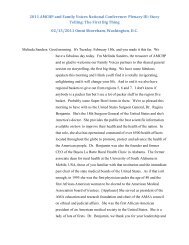



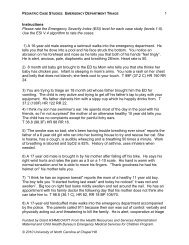
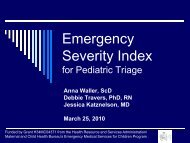
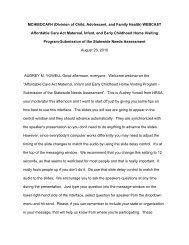
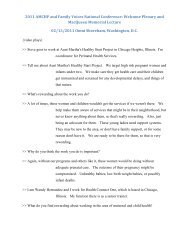
![Hormone Disruptors and Women's Health: Reasons for Concern [PDF]](https://img.yumpu.com/19410002/1/190x245/hormone-disruptors-and-womens-health-reasons-for-concern-pdf.jpg?quality=85)

